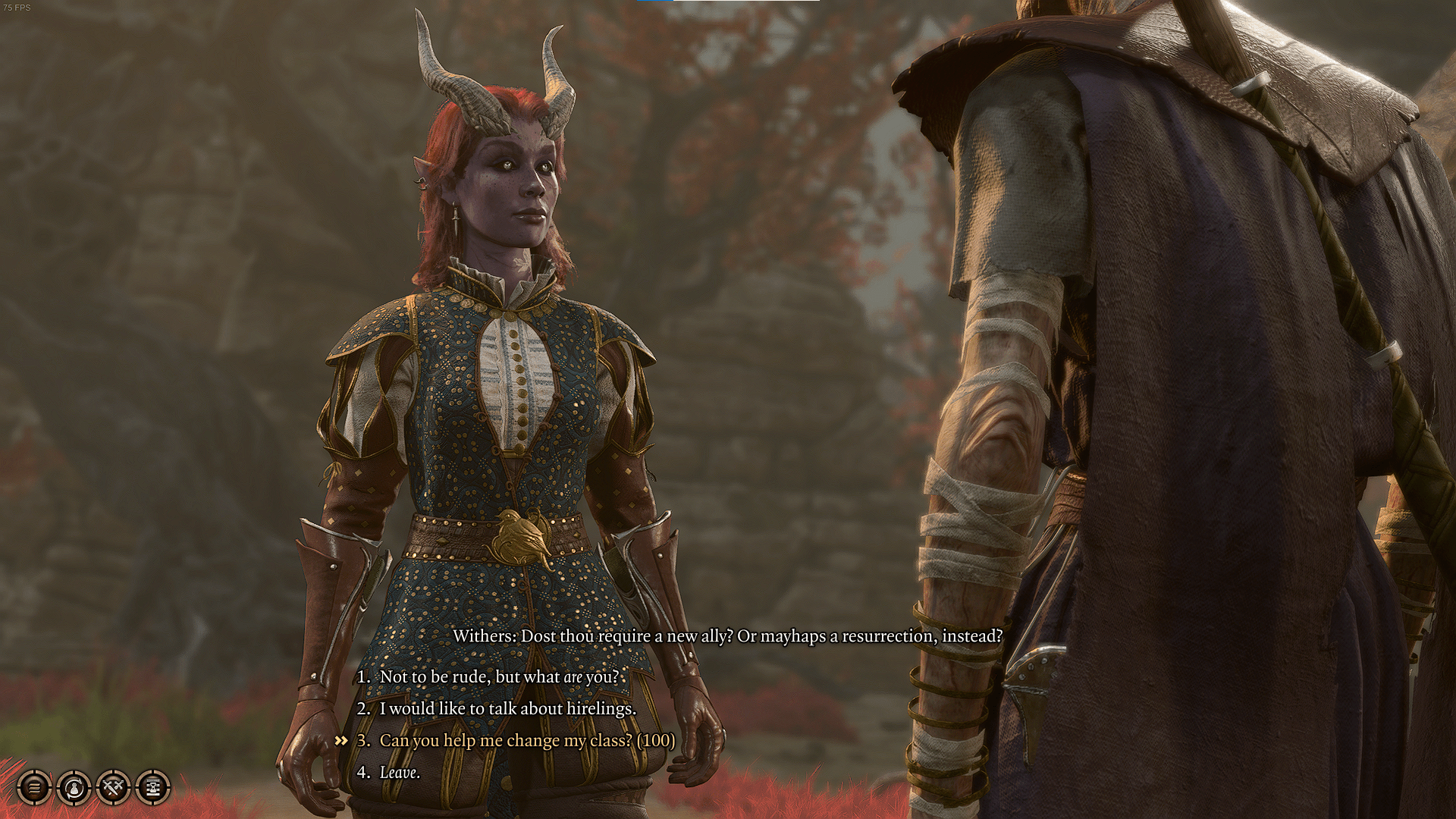College of Valor Bard Build and Guide
When it comes to combat utility and the art of the spoken word, very few BG3 classes outshine the College of Valor Bard.
Well-known for their promiscuity, Bards provide a welcomed edge in dialogue and on the battlefield with their many Charisma Proficiencies and supportive spells.
The College of Valor subclass allows you to specialize your Bard for battle, with improved combat sturdiness and utility.
This College of Valor build guide will go until Level 6 and will be updated as I reach higher levels.
Find out where the Bard ranks in our Baldur’s Gate 3 class tier list.
Pros and Cons
Pros
- Very strong support capabilities
- Good survivability due to Medium Armor and Shield Proficiency
- Great out-of-combat utility
Cons
- Not as much damage as other subclasses
- Many spells require Concentration
- Doesn’t have access to Cutting Words
College of Valor Bards are a great mix of support and defense, as they gain access to Combat Inspiration and Medium Armor Proficiency. They’re the only Bard subclass that gets Shield Proficiency as well, which only boosts their defensiveness.
Bardic Inspiration is one of the best Actions in Baldur’s Gate 3, as it can be used in either combat or exploration to gain the upper hand in a diverse selection of situations. Because of their high Charisma, Bards provide players with a more dialogue-focused playthrough which is wonderful for uncovering the hidden lore of Faerûn.
Additionally, College of Valor Bards gain Jack of all Trades and Expertise Proficiencies at Levels 2 and 3, which just furthers their out-of-combat dialogue Proficiency Checks, such as Persuasion, Deception, or Performance.
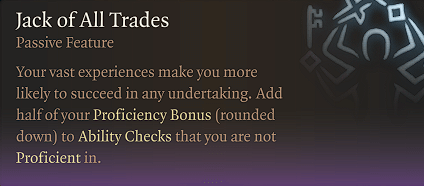
The main problems with College of Valor Bards stems from their lower damage output. College of Lore Bards gain access to more Spells and Spell Slots, while College of Sword Bards gain many offensive flourishes. College of Valor Bards are meant to fill a melee-focused role, with their Medium Armor and Shield Proficiency, and can lack in damage when compared to other Bard subclasses and other classes in general.
Despite this subclass being more combat-focused than a College of Lore Bard, they miss out on the added utility of having Cutting Words, one of the most useful combat skills a Bard can have access to.
Additionally, a large amount of a College of Valor Bard’s spells require Concentration; however, characters can only concentrate on one spell at a time. This requires you to be more strategic when thinking of spell placements so that you don’t waste your spell slots.
Races
When it comes to the best race for a Valor Bard, it’s almost completely up to personal preference. Zariel Tieflings gain access to the Thaumaturgy Cantrip, giving you a bonus to Intimidation and Performance ability checks.
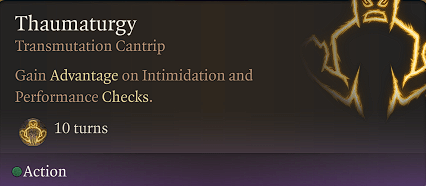
No other race has any Charisma bonuses or traits. Because of this, I recommend either choosing this Tiefling subrace or just choosing any race you like personally and adding +2 in Charisma and +1 in Constitution under the Abilities tab.
Stats
A Bard’s highest Ability Score should be Charisma since it’s your abilities’ modifier. Your Constitution and Dexterity are also very important and should have the second most amount of Ability Points invested.
Since you gain Medium Armor Proficiency at Level 3, having high Dexterity will help your early game skirmishes as well as increase your Armor Class (AC) by +2 when you wear Medium Armor. Constitution is also very important as it’ll increase your character’s max HP.
Having a high Constitution score also helps you succeed in Constitution Saving Throws, and are very important for Bards as they have many Concentration abilities. The rest of your points can be allocated as you wish, depending on what Skill Checks you’d like to pass.
I recommend Wisdom so you can pass Insight Checks easily during dialogue, typically unlocking additional dialogue options. Your Ability Points can look something like this:
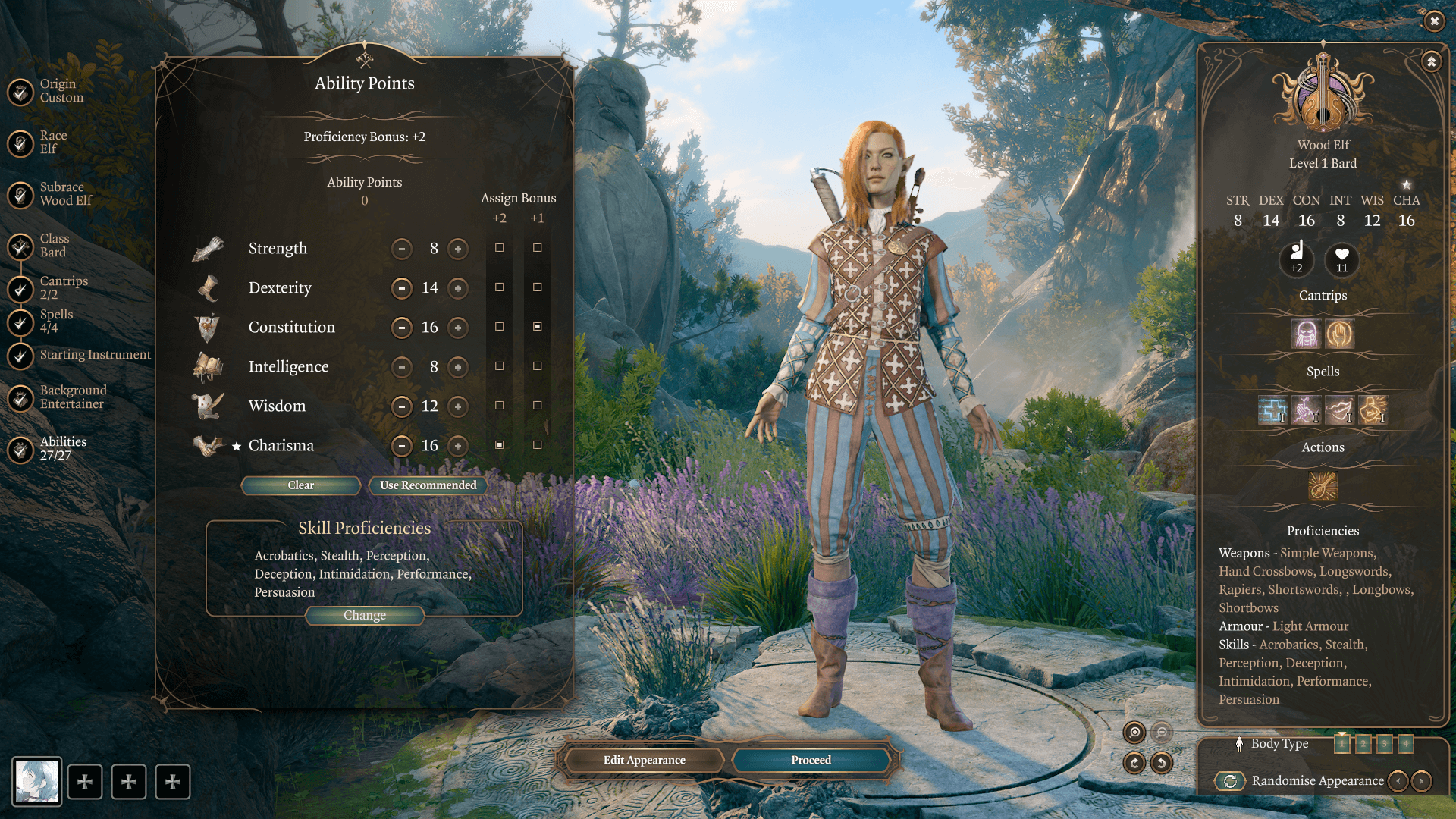
Backgrounds and Proficiencies
The most optimal Bard backgrounds are ones that provide Charisma skills.
Recommended backgrounds:
- Criminal: Deception and Stealth
- Entertainer: Acrobatics and Performance
- Guild Artisan: Insight and Persuasion
- Noble: History and Persuasion
- Soldier: Athletics and Intimidation
Depending on what Ability you chose to invest extra Ability Points into, you should choose a background that has its skill. For example, if you invested Ability Points into Intelligence, then it’s not a bad idea to choose the Noble Background.
When choosing your skills, selecting anything that provides Charisma or Dexterity Skills will serve you well. I recommend choosing Persuasion, Insight, Performance, or Deception. You should choose your skills depending on what dialogue options you’d like to pick during conversation. You’ll also gain the option to choose your Musical Instrument. This is purely to determine the sound effects your abilities have and has no effect on actual attacks in combat, so just choose whichever one you like most. If the instrument you chose in the beginning is not to your liking, you’re also able to find all the instruments while exploring.
Recommended Spells and Abilities
While College of Valor Bards don’t have access to as many spells as their Lore counterparts, they still have a decent selection. Their main Class Action, Bardic Inspiration, is extremely versatile.
Level 1
At Level 1, Bardic Inspiration is an ability that gives any ally an added +1d6 bonus to their next Attack Roll, Ability Check, or Saving Throw.
You can use Bardic Inspiration in combat or dialogue. Until Level 5, you can only replenish this ability with a Long Rest. This is why it’s very important to save your Bardic Inspiration for important battles or checks until you get more char
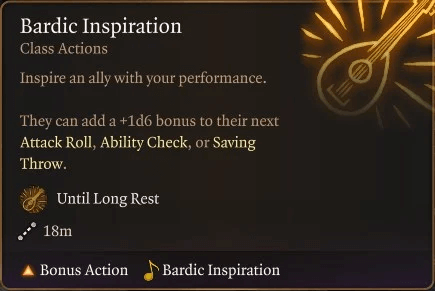
Depending on what kind of support role you’d like your College of Valor Bard to play, then your Level 1 Spells can change. If you’d like your Bard to be a de-buffer and Crowd Control enemies, then taking Tasha’s Hideous Laughter, Sleep, Faerie Fire, or Bane as spells is a great choice. If you’d like your Bard to be more like a healer, then taking Healing Word or Heroism will serve you well.
You could also mix both routes, which will make you more adaptable and what I personally recommend. No matter what route you decide to go, I recommend taking Vicious Mockery as a cantrip and Dissonant Whispers as a spell since both have very good damage and utility. Additionally, Vicious Mockery is a cantrip, so it won’t use any Spell Slots.
When choosing your secondary cantrip, pick depending on what team you plan on having. If the race you’re playing doesn’t have Darkvision, then it’s a good idea to use Dancing Lights as your secondary cantrip. If you do have Darkvision, then choose either Friends or Mage Hand. Your spells can look something like this:

Spells like Tasha’s Hideous Laughter and Faerie Fire both require Concentration. This means that if you’re hit while Concentrating, the effects of the Spell can end if you fail a Constitution Saving Throw. This is why Constitution is such an important Ability for Bards, as many of their powerful spells can be canceled.
Level 2
At Level 2, you gain access to Jack of All Trades, Song of Rest, and more Spells. Jack of All Trades just furthers your out-of-combat utility, as it lets you add half of your Proficiency Bonus to non-Proficient Skill checks. Song of Rest is basically just another Short Rest, which is just a generally good thing to have.
I recommend picking Faerie Fire, Bane, or Charm Person depending on what spells you chose Level 1. All are great de-buffers for enemies, and Faerie Fire especially is great as it makes all enemies visible and all allies gain Advantage on attack rolls against targets within the light.
As you play and level up, you’ll gain access to many new Spells and Cantrips. However, like Sorcerers, you can’t Prepare Spells. This means you’ll learn a finite amount of spells throughout your playthrough.
You must be selective in what spells you choose to learn since you won’t have access to every single Bard spell at any given time, and can only change them out whenever you level up or by speaking to Withers.
Level 3
When you reach Level 3, you’ll be able to pick your Bard subclass, choose your Skills with Expertise, and learn a Level 2 spell. College of Valor turns your Bardic Inspiration charges into Combat Inspiration.
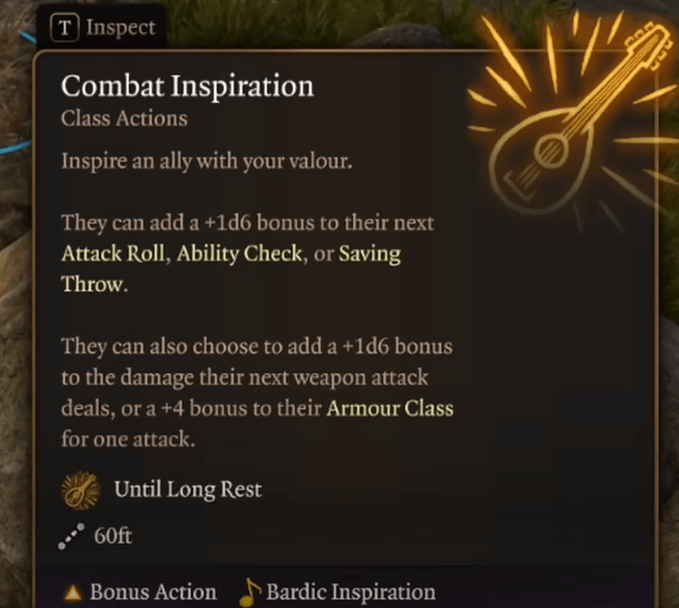
Instead of only being able to give an ally an added +1d6 bonus to their next Attack Roll, Ability Check, or Saving Throw, you now have the option of adding a +1d6 bonus to their next Attack Roll, Ability Check. Saving Throw, weapon damage, or Armor Class. This greatly improves Bardic Inspiration, as it makes it much more versatile for different situations.
You’re also able to choose 2 skills with Expertise. Expertise is a class ability that allows you to double your Proficiency Bonus on a skill. I recommend choosing any Skill you notice you enjoy using. If you enjoy persuading people and performing, then choose Persuasion and Performance as your Skills with Expertise.
When choosing your new Level 2 Spell, there are many good options, and you should pick depending on your team comp and what you need. I recommend picking from the following.
Best Valor Bard Level 2 Spells
- Cloud of Daggers: Conjure a cloud of spinning daggers that attack anyone inside for 4d4 Slashing damage. This is a great spell for zoning and is great to place down in areas where enemies must pass through, such as entrances or narrow areas. However, allies can also be hit by the daggers, so be careful when casting.
- Shatter: Damages all nearby creatures and objects for 3d8 Thunder damage. This spell does very good damage, and is able to target multiple enemies at once. It’s a good spell to choose if you’re lacking AoE damage in your team.
- Hold Person: Hold a humanoid enemy still. They can’t move, act, or react and attacks from within 3m are always Critical Hits. This is a very good supportive spell, as you can lock down difficult enemies for your team. The only drawbacks are that it’s useless in fights against non-humanoid entities and it requires Concentration.
- Lesser Restoration: Cure a creature from disease, poison, paralysis, or blindness. This is just a generally good support ability since it acts as a cleanse.
Lastly, you’ll also gain your new Valor Bard Proficiencies.
Level 4
Once you reach Level 4, you’ll be able to pick a Feat, an additional Level 2 spell, and a new Cantrip. I recommend picking Ability Improvement as your Feat so you can make your Charisma 18, which will only buff your spells and abilities.
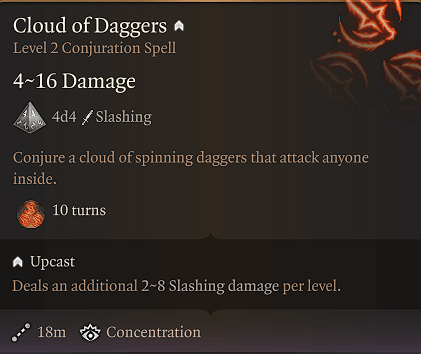
For your new cantrip, choose the cantrip you didn’t choose at Level 1. For example, if you picked Dancing Lights then choose Friends. Lastly, choose any Level 2 spell listed before as your new spell.
Level 5
At Level 5, you’ll gain access to Font of Inspiration and Improved Combat Inspiration. Font of Inspiration allows you to gain back all Combat Inspiration with a Short Rest. This is really good because you don’t have to waste Camp Supplies to refill your charges. Improved Bardic Inspiration increases Combat Inspiration to 1d8 from 1d6.
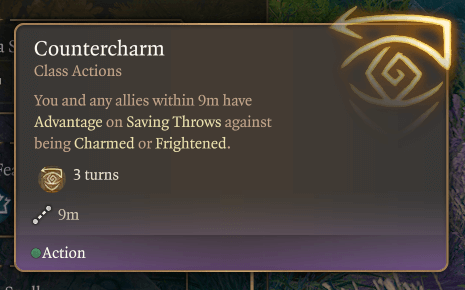
Lastly, when you gain access to level 5 spells, you should take Glyph of Warding. It allows you to cast a giant circular glyph on the ground. If an enemy walks over it, then depending on the element of the glyph, different things can happen.
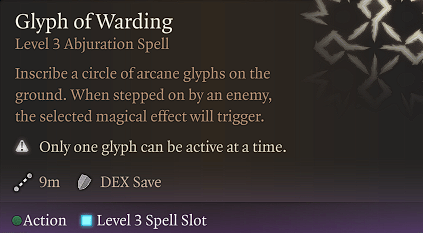
This includes large AoE elemental damage, pushing enemies back, and putting enemies to Sleep. Allies can be hit by the AoE caused by enemies activating this ability, so be careful with positioning.
I also recommend switching Tasha’s Hideous Laughter out for Fear. This Level 3 Spell summons a large cone that Fears enemies and can cause them to drop their weapons. It’s one of the best Level 3 Crowd Control spells.
Level 6
When you reach Level 6, you’ll gain access to Countercharm, Extra Attack, and a new Level 3 spell. Countercharm gives an advantage on Saving Throws against being Charmed or Frightened. This can be a great spell, as you can keep your team from being CC’d.
You also gain an extra melee attack. I would recommend picking up Warden of Vitality as your level 3 spell. It essentially acts as Healing Word, but can be used multiple times as a Bonus Action across 10 turns without expending an additional Spell Slot.

A downside of this spell is that your party members need to be closer to you in order to take advantage of it.
Equipment
For equipment, I recommend picking any one-handed weapon with a bonus and a shield. This will maximize your AC and damage. I recommend choosing a Mace or a sword. You should also equip a longbow, as your Dexterity is enough to do decent ranged damage.
The best armor for College of Valour Bards is Medium Armor due to your Proficiency. Wearing Medium Armor will increase your AC and make you harder to kill. I recommend Scale Mail or the Githyanki Half Plate. You can find Scale Mail being sold by merchants or on corpses, and Githyanki Half Plates can be found on dead Githyanki or by stealing Lae’zel’s.
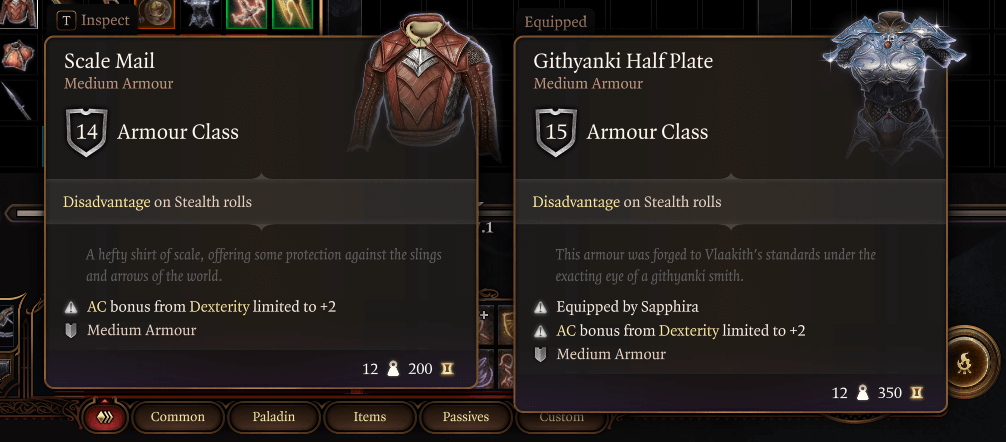
I recommend wearing the Cap of Curing since Bards are the only class that can make use of its benefits. If you use Bardic Inspiration on an ally while wearing this hat, the target will gain 1d6 HP.
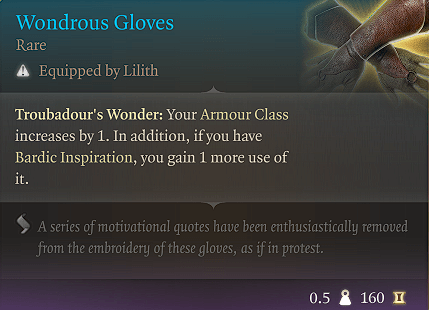
This hat is found in a Gilded Chest near the Druid Grove, next to the Bard NPC, Alfira. The Wondrous Gloves, dropped by a Mimic in the Grymforge, provide you with an additional charge of Bardic/Combat Inspiration.
Conclusion
The tankiest of Bard classes, College of Valour Bard is a great option for anyone who wants better frontline options for their team. Taking advantage of their Class Action with an improved Bardic Inspiration, you can rely on them to provide excellent utility to any team.
 Download APP
Download APP